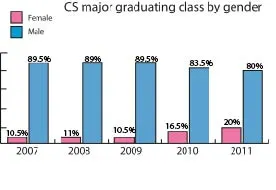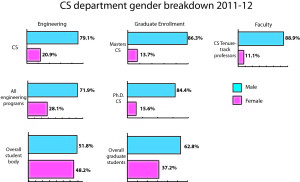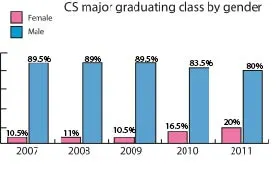
Computer science (CS) is Stanford’s most popular major, but not all students flock to the department equally; women make up only 20.9 percent of undergraduate computer science majors, a disparity shared by colleges across the nation.
While women’s enrollment in CS at Stanford has increased over the past two years, department faculty believe the problem has its roots long before most women set foot on a college campus.
“The one thing I would say people seem relatively conclusive about is that it starts earlier than college,” said Jennifer Widom, professor and chair of the Computer Science Department.
The gender disparity found in college departments is also noticeable at the high school level and below. This means that fewer women enter college with an interest in computer science, and those who do often lack the experience of their male counterparts.
“Women come in maybe with less background in CS, because the problem is actually earlier and so they get intimidated by these men who come in having programmed since they were in the third grade,” Widom said.
The challenge for the computer science department is how to make CS accessible to women once they get to college. In addition to drawing women to the major, there is often a struggle to keep them involved. Entry-level courses such as CS106A exhibit near parity, but the drop-off is steep. Women receive just 20.9 percent of bachelor’s degrees conferred in computer science, 13.7 percent of master’s degrees and 15.6 percent of doctoral degrees.

This drop-off persists despite rising demand for computer science degrees in the job market.
“The number of computer science majors that are being produced these days is just far below the demand from industry in terms of the number of positions that are open,” associate professor of computer science Mehran Sahami, BS ’92, M.S. ’93, Ph.D. ’99, said.
Students and faculty believe a negative stereotype of the CS student works against women considering the field.
“The image of CS…is something that’s not very attractive to women in particular,” CS major Sophia Westwood ’13 said. “So, for example, if you look at ‘The Social Network’ and you see a guy who’s not very socially adept, kind of a loser, alone in his room…It’s not really an image that appeals to a lot of guys certainly, but particularly not to women.”
However, Westwood doesn’t buy into this image, and feels that a CS degree has a lot to offer women.
“One of the most important things is that that image isn’t true, that there’s all sorts of things you could do with a CS major,” she said.
In an effort to keep up with developments in the field, Stanford revised its curriculum in the 2008-09 school year to diversify what many perceived as a monolithic course offering by the department. Students now have their choice of several different tracks, with concentrations ranging from graphics to human-computer interaction.
Since 2009, the number of women majoring in CS has increased by 9.5 percent, which Sahami said is a direct result of the curriculum change.
One outreach effort organized by students to promote women in the field is a set of bi-quarterly dinners for women interested or involved in computer science held by the campus group She++. The dinners give freshmen and sophomores a chance to meet female upperclassmen in the department as well as industry professionals.
“Women who find more women to be with in computer science, that makes a big difference,” Widom said. “Just the fact that our major is expanding means that there are more women involved in our major…So just making sure these women meet each other is a useful thing.”
One point, emphasized by Westwood, is that most women take introductory CS classes after having declared their major.
“If you ask people later, ‘Do you wish that you had taken this class earlier?’ most of them say ‘Yes,’” Westwood said.
For now, the rapidly expanding department is keeping its hopes high. According to Sahami, the goal is equal representation of genders in the major.
